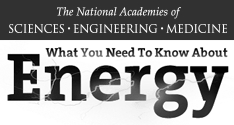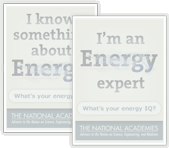
What You Need To Know About Energy
What do you know about energy?
What percentage of commercial building energy is used by schools?
-
Sorry, that’s incorrect.
School buildings represent 13% of commercial buildings energy use, or about 2.5% of total U.S. energy use (13% × 19%).
-
Sorry, that’s incorrect.
School buildings represent 13% of commercial buildings energy use, or about 2.5% of total U.S. energy use (13% × 19%).
-
Correct!
School buildings represent 13% of commercial buildings energy use, or about 2.5% of total U.S. energy use (13% × 19%).
-
Sorry, that’s incorrect.
School buildings represent 13% of commercial buildings energy use, or about 2.5% of total U.S. energy use (13% × 19%).
Which of the following is not a primary energy source?
-
Sorry, that’s incorrect.
Electricity is a secondary energy source because it can only be produced from the use of primary energy sources such as coal, natural gas, or nuclear reactions.
-
Sorry, that’s incorrect.
Electricity is a secondary energy source because it can only be produced from the use of primary energy sources such as coal, natural gas, or nuclear reactions.
-
Correct!
Electricity is a secondary energy source because it can only be produced from the use of primary energy sources such as coal, natural gas, or nuclear reactions.
-
Sorry, that’s incorrect.
Electricity is a secondary energy source because it can only be produced from the use of primary energy sources such as coal, natural gas, or nuclear reactions.
-
Sorry, that’s incorrect.
Electricity is a secondary energy source because it can only be produced from the use of primary energy sources such as coal, natural gas, or nuclear reactions.
In 2014, of the four economic sectors, which used the most energy in the United States?
-
Sorry, that’s incorrect.
In 2014, the industrial sector represented 32% of U.S. energy use, while transportation was 28%. Residential and commercial were 22% and 19% respectively.
-
Sorry, that’s incorrect.
In 2014, the industrial sector represented 32% of U.S. energy use, while transportation was 28%. Residential and commercial were 22% and 19% respectively.
-
Correct!
In 2014, the industrial sector represented 32% of U.S. energy use, while transportation was 28%. Residential and commercial were 22% and 19% respectively.
-
Sorry, that’s incorrect.
In 2014, the industrial sector represented 32% of U.S. energy use, while transportation was 28%. Residential and commercial were 22% and 19% respectively.
Since the beginning of the industrial revolution, about how much have atmospheric carbon dioxide concentrations increased?
-
Correct!
CO2 concentration in the atmosphere has risen about 43% since the beginning of the industrial revolution in the mid-eighteenth century-half of that since 1980
-
Sorry, that’s incorrect.
CO2 concentration in the atmosphere has risen about 43% since the beginning of the industrial revolution in the mid-eighteenth century-half of that since 1980
-
Sorry, that’s incorrect.
CO2 concentration in the atmosphere has risen about 43% since the beginning of the industrial revolution in the mid-eighteenth century-half of that since 1980
-
Sorry, that’s incorrect.
CO2 concentration in the atmosphere has risen about 43% since the beginning of the industrial revolution in the mid-eighteenth century-half of that since 1980
What is the largest reservoir of stored solar energy?
-
Sorry, that’s incorrect.
Fossil fuels represent the largest source of stored solar energy, resulting from the transformation of biomass over millions of years into oil, natural gas and coal.
-
Sorry, that’s incorrect.
Fossil fuels represent the largest source of stored solar energy, resulting from the transformation of biomass over millions of years into oil, natural gas and coal.
-
Correct!
Fossil fuels represent the largest source of stored solar energy, resulting from the transformation of biomass over millions of years into oil, natural gas and coal.
Energy intensity is a measure of:
- The amount of energy used by a nation per unit of GDP
- The amount of energy contained in a given amount of fuel
- The amount of electric current passing through a point
-
Correct!
Energy intensity is a measure of a nation's energy efficiency represented through energy use per unit of GDP (Gross Domestic Product).
-
Sorry, that’s incorrect.
Energy intensity is a measure of a nation's energy efficiency represented through energy use per unit of GDP (Gross Domestic Product).
-
Sorry, that’s incorrect.
Energy intensity is a measure of a nation's energy efficiency represented through energy use per unit of GDP (Gross Domestic Product).
What are ways that electricity system operators match power needs to generation on a day-to-day basis?
- Turning on or off adjustable, load-following generators
- Turning on or off short-term "peaker" plants
- Initiating demand-response actions, such as adjusting thermostats for customers who have agreed to it.
- Initiating energy storage, such as pumped hydro or battery storage.
- All of the above
-
Sorry, that’s incorrect.
Load-following and peaker plants, demand-response and energy storage are all ways that grid operators can adjust generation to meet demand.
-
Sorry, that’s incorrect.
Load-following and peaker plants, demand-response and energy storage are all ways that grid operators can adjust generation to meet demand.
-
Sorry, that’s incorrect.
Load-following and peaker plants, demand-response and energy storage are all ways that grid operators can adjust generation to meet demand.
-
Sorry, that’s incorrect.
Load-following and peaker plants, demand-response and energy storage are all ways that grid operators can adjust generation to meet demand.
-
Correct!
Load-following and peaker plants, demand-response and energy storage are all ways that grid operators can adjust generation to meet demand.
Which of the following is not considered to be a drawback to wind energy?
- Wind's intermittency
- Aesthetic impact of wind farms
- Risks to birds and bats
- All of the above are considered drawbacks
-
Sorry, that’s incorrect.
While wind energy has many benefits, all of the above are considered drawbacks to wind energy.
-
Sorry, that’s incorrect.
While wind energy has many benefits, all of the above are considered drawbacks to wind energy.
-
Sorry, that’s incorrect.
While wind energy has many benefits, all of the above are considered drawbacks to wind energy.
-
Correct!
While wind energy has many benefits, all of the above are considered drawbacks to wind energy.
Combustion of gasoline and diesel fuel emits which of the following?
-
Sorry, that’s incorrect.
All of the above are emitted by vehicles running on gasoline and diesel fuel.
-
Sorry, that’s incorrect.
All of the above are emitted by vehicles running on gasoline and diesel fuel.
-
Sorry, that’s incorrect.
All of the above are emitted by vehicles running on gasoline and diesel fuel.
-
Sorry, that’s incorrect.
All of the above are emitted by vehicles running on gasoline and diesel fuel.
-
Correct!
All of the above are emitted by vehicles running on gasoline and diesel fuel.
Thank you for taking our quiz.
Place this badge on your facebook page to show your friends what you know about energy.
Place this badge on your facebook page to show your friends what you know about energy.
Place this badge on your facebook page to show your friends what you know about energy.
Explore Other Topics
Energy Hands-on
Understanding Efficiency
Learn the significance of energy efficiencyThe Promise of Better Lighting
Energy savings through lighting technologyOur Energy System
A visualization of all our energy sourcesEnergy Defined
- Energy Independence and Security Act of 2007
An act of Congress regarding the energy policy of the United States that was primarily focused on automobile fuel economy, development of biofuels, and energy efficiency in public buildings and lighting.




